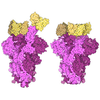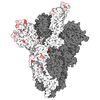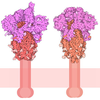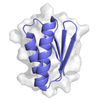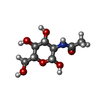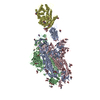+ データを開く
データを開く
- 基本情報
基本情報
| 登録情報 | データベース: PDB / ID: 9bll | ||||||
|---|---|---|---|---|---|---|---|
| タイトル | Cryo-EM of RBD(EG5.1)/1301B7 Fab Complex | ||||||
 要素 要素 |
| ||||||
 キーワード キーワード | VIRAL PROTEIN/IMMUNE SYSTEM / Fab / RBD / Complex / PROTEIN BINDING / VIRAL PROTEIN-IMMUNE SYSTEM complex | ||||||
| 機能・相同性 |  機能・相同性情報 機能・相同性情報Maturation of spike protein / viral translation / Translation of Structural Proteins / Virion Assembly and Release / host cell surface / host extracellular space / symbiont-mediated-mediated suppression of host tetherin activity / Induction of Cell-Cell Fusion / structural constituent of virion / entry receptor-mediated virion attachment to host cell ...Maturation of spike protein / viral translation / Translation of Structural Proteins / Virion Assembly and Release / host cell surface / host extracellular space / symbiont-mediated-mediated suppression of host tetherin activity / Induction of Cell-Cell Fusion / structural constituent of virion / entry receptor-mediated virion attachment to host cell / membrane fusion / Attachment and Entry / host cell endoplasmic reticulum-Golgi intermediate compartment membrane / positive regulation of viral entry into host cell / receptor-mediated virion attachment to host cell / host cell surface receptor binding / symbiont-mediated suppression of host innate immune response / receptor ligand activity / endocytosis involved in viral entry into host cell / fusion of virus membrane with host plasma membrane / fusion of virus membrane with host endosome membrane / viral envelope / virion attachment to host cell / SARS-CoV-2 activates/modulates innate and adaptive immune responses / host cell plasma membrane / virion membrane / identical protein binding / membrane / plasma membrane 類似検索 - 分子機能 | ||||||
| 生物種 |  Homo sapiens (ヒト) Homo sapiens (ヒト) | ||||||
| 手法 | 電子顕微鏡法 / 単粒子再構成法 / クライオ電子顕微鏡法 / 解像度: 4.1 Å | ||||||
 データ登録者 データ登録者 | Walter, M.R. / Green, T.J. | ||||||
| 資金援助 |  米国, 1件 米国, 1件
| ||||||
 引用 引用 |  ジャーナル: Npj Viruses / 年: 2024 ジャーナル: Npj Viruses / 年: 2024タイトル: Potent neutralization by a RBD antibody with broad specificity for SARS-CoV-2 JN.1 and other variants. 著者: Michael S Piepenbrink / Ahmed Magdy Khalil / Ana Chang / Ahmed Mostafa / Madhubanti Basu / Sanghita Sarkar / Simran Panjwani / Yaelyn H Ha / Yao Ma / Chengjin Ye / Qian Wang / Todd J Green / ...著者: Michael S Piepenbrink / Ahmed Magdy Khalil / Ana Chang / Ahmed Mostafa / Madhubanti Basu / Sanghita Sarkar / Simran Panjwani / Yaelyn H Ha / Yao Ma / Chengjin Ye / Qian Wang / Todd J Green / James L Kizziah / Nathaniel B Erdmann / Paul A Goepfert / Lihong Liu / David D Ho / Luis Martinez-Sobrido / Mark R Walter / James J Kobie /   要旨: SARS-CoV-2 continues to be a public health burden, driven in-part by its continued antigenic diversification and resulting emergence of new variants. By increasing herd immunity, current vaccines ...SARS-CoV-2 continues to be a public health burden, driven in-part by its continued antigenic diversification and resulting emergence of new variants. By increasing herd immunity, current vaccines have improved infection outcomes for many. However, prophylactic and treatment interventions that are not compromised by viral evolution of the Spike protein are still needed. Using a differential staining strategy with a rationally designed SARS-CoV-2 Receptor Binding Domain (RBD) - ACE2 fusion protein and a native Omicron RBD protein, we developed a recombinant human monoclonal antibody (hmAb) from a convalescent individual following SARS-CoV-2 Omicron infection. The resulting hmAb, 1301B7 potently neutralized a wide range of SARS-CoV-2 variants including the original Wuhan-1, the more recent Omicron JN.1 strain, and SARS-CoV. 1301B7 contacts the ACE2 binding site of RBD exclusively through its VH1-69 heavy chain. Broad specificity is achieved through 1301B7 binding to many conserved residues of Omicron variants including Y501 and H505. Consistent with its extensive binding epitope, 1301B7 is able to potently diminish viral burden in the upper and lower respiratory tract and protect mice from challenge with Omicron XBB1.5 and Omicron JN.1 viruses. These results suggest 1301B7 has broad potential to prevent or treat clinical SARS-CoV-2 infections and to guide development of RBD-based universal SARS-CoV-2 prophylactic vaccines and therapeutic approaches. | ||||||
| 履歴 |
|
- 構造の表示
構造の表示
| 構造ビューア | 分子:  Molmil Molmil Jmol/JSmol Jmol/JSmol |
|---|
- ダウンロードとリンク
ダウンロードとリンク
- ダウンロード
ダウンロード
| PDBx/mmCIF形式 |  9bll.cif.gz 9bll.cif.gz | 115.4 KB | 表示 |  PDBx/mmCIF形式 PDBx/mmCIF形式 |
|---|---|---|---|---|
| PDB形式 |  pdb9bll.ent.gz pdb9bll.ent.gz | 73.6 KB | 表示 |  PDB形式 PDB形式 |
| PDBx/mmJSON形式 |  9bll.json.gz 9bll.json.gz | ツリー表示 |  PDBx/mmJSON形式 PDBx/mmJSON形式 | |
| その他 |  その他のダウンロード その他のダウンロード |
-検証レポート
| 文書・要旨 |  9bll_validation.pdf.gz 9bll_validation.pdf.gz | 1.4 MB | 表示 |  wwPDB検証レポート wwPDB検証レポート |
|---|---|---|---|---|
| 文書・詳細版 |  9bll_full_validation.pdf.gz 9bll_full_validation.pdf.gz | 1.4 MB | 表示 | |
| XML形式データ |  9bll_validation.xml.gz 9bll_validation.xml.gz | 36.6 KB | 表示 | |
| CIF形式データ |  9bll_validation.cif.gz 9bll_validation.cif.gz | 51.4 KB | 表示 | |
| アーカイブディレクトリ |  https://data.pdbj.org/pub/pdb/validation_reports/bl/9bll https://data.pdbj.org/pub/pdb/validation_reports/bl/9bll ftp://data.pdbj.org/pub/pdb/validation_reports/bl/9bll ftp://data.pdbj.org/pub/pdb/validation_reports/bl/9bll | HTTPS FTP |
-関連構造データ
| 関連構造データ |  44666MC M: このデータのモデリングに利用したマップデータ C: 同じ文献を引用 ( |
|---|---|
| 類似構造データ | 類似検索 - 機能・相同性  F&H 検索 F&H 検索 |
- リンク
リンク
- 集合体
集合体
| 登録構造単位 | 
|
|---|---|
| 1 |
|
- 要素
要素
| #1: 抗体 | 分子量: 13768.365 Da / 分子数: 1 / 由来タイプ: 組換発現 / 由来: (組換発現)  Homo sapiens (ヒト) / 発現宿主: Homo sapiens (ヒト) / 発現宿主:  Homo sapiens (ヒト) Homo sapiens (ヒト) |
|---|---|
| #2: 抗体 | 分子量: 11517.782 Da / 分子数: 1 / 由来タイプ: 組換発現 / 由来: (組換発現)  Homo sapiens (ヒト) / 発現宿主: Homo sapiens (ヒト) / 発現宿主:  Homo sapiens (ヒト) Homo sapiens (ヒト) |
| #3: タンパク質 | 分子量: 137934.078 Da / 分子数: 1 / Fragment: RBD(EG5.1) / 由来タイプ: 組換発現 由来: (組換発現)  遺伝子: S, 2 / 発現宿主:  Homo sapiens (ヒト) / 参照: UniProt: P0DTC2 Homo sapiens (ヒト) / 参照: UniProt: P0DTC2 |
| #4: 多糖 | 2-acetamido-2-deoxy-beta-D-glucopyranose-(1-4)-2-acetamido-2-deoxy-beta-D-glucopyranose |
| #5: 糖 | ChemComp-NAG / |
| 研究の焦点であるリガンドがあるか | Y |
| Has protein modification | Y |
-実験情報
-実験
| 実験 | 手法: 電子顕微鏡法 |
|---|---|
| EM実験 | 試料の集合状態: PARTICLE / 3次元再構成法: 単粒子再構成法 |
- 試料調製
試料調製
| 構成要素 | 名称: Complex of RBDeg5.1 with Fab 1301B7 / タイプ: COMPLEX / 詳細: Fab generated by proteolytic cleavage / Entity ID: #1-#3 / 由来: RECOMBINANT | ||||||||||||
|---|---|---|---|---|---|---|---|---|---|---|---|---|---|
| 分子量 | 実験値: NO | ||||||||||||
| 由来(天然) | 生物種:  Homo sapiens (ヒト) Homo sapiens (ヒト) | ||||||||||||
| 由来(組換発現) | 生物種:  Homo sapiens (ヒト) Homo sapiens (ヒト) | ||||||||||||
| 緩衝液 | pH: 7.5 | ||||||||||||
| 緩衝液成分 |
| ||||||||||||
| 試料 | 濃度: 1.5 mg/ml / 包埋: NO / シャドウイング: NO / 染色: NO / 凍結: YES | ||||||||||||
| 急速凍結 | 装置: FEI VITROBOT MARK IV / 凍結剤: ETHANE / 湿度: 95 % / 凍結前の試料温度: 298 K |
- 電子顕微鏡撮影
電子顕微鏡撮影
| 顕微鏡 | モデル: TFS GLACIOS |
|---|---|
| 電子銃 | 電子線源:  FIELD EMISSION GUN / 加速電圧: 200 kV / 照射モード: FLOOD BEAM FIELD EMISSION GUN / 加速電圧: 200 kV / 照射モード: FLOOD BEAM |
| 電子レンズ | モード: BRIGHT FIELD / 最大 デフォーカス(公称値): 2000 nm / 最小 デフォーカス(公称値): 750 nm |
| 撮影 | 電子線照射量: 50 e/Å2 フィルム・検出器のモデル: TFS FALCON 4i (4k x 4k) |
- 解析
解析
| EMソフトウェア |
| ||||||||||||||||||||||||||||||||||||||||||||
|---|---|---|---|---|---|---|---|---|---|---|---|---|---|---|---|---|---|---|---|---|---|---|---|---|---|---|---|---|---|---|---|---|---|---|---|---|---|---|---|---|---|---|---|---|---|
| CTF補正 | タイプ: PHASE FLIPPING AND AMPLITUDE CORRECTION | ||||||||||||||||||||||||||||||||||||||||||||
| 粒子像の選択 | 選択した粒子像数: 1113228 | ||||||||||||||||||||||||||||||||||||||||||||
| 3次元再構成 | 解像度: 4.1 Å / 解像度の算出法: FSC 0.143 CUT-OFF / 粒子像の数: 88411 / アルゴリズム: FOURIER SPACE / クラス平均像の数: 5 / 対称性のタイプ: POINT | ||||||||||||||||||||||||||||||||||||||||||||
| 原子モデル構築 | プロトコル: RIGID BODY FIT / 空間: REAL | ||||||||||||||||||||||||||||||||||||||||||||
| 原子モデル構築 | 3D fitting-ID: 1
|
 ムービー
ムービー コントローラー
コントローラー



 PDBj
PDBj